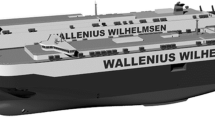Abstract
The methodology to obtain the non-linear roll damping from decay tests is very old. It has been proposed by Froude in the 19th century and used from then on. Behind it there is a quadratic model \( [\dot \theta |\dot \theta |] \) for the damping and a subsequent equivalent linearization. Probably all model basin in the world follows this approach to assess the damping from a decay test. This is well documented and so is the methods to get the p 1−p 2 coefficients. This is very general in the sense that in principle, it could be applied to any kind of hull. However, it has become clear that for hull with a flat bottom such as a very large crude carrier (VLCC), this approach may lead to confusing results such as negative p 2. Faced with this, the work presents a completely new idea. Avoiding the polynomial approximation, the basic attitude is to devise two regions from the decaying test response. The first, called the large amplitude response region yields a larger damping, probably due to the large bilge keel vortices that are attracted to the hull flat bottom. The second is the small amplitude response region where the vortices are not attracted to the bottom but travels approximately 45° sidewise. These observations has led to a new approach called the bi-linear approach as discussed in the work after analyzing several (many) model test results. In fact, a new modified bi-linear approach is ultimately proposed after the understanding of a transition region instead of a transition angle.
Similar content being viewed by others
References
FROUDE W. On the influence of resistance upon the rolling of ships[J]. Naval Science, 1872, 1: 411–429.
IKEDA Y, HIMENO Y, TANAKA N. On roll damping force of ship-effects of friction on hull and normal force on bilge keels[J]. Journal of Kansai Society of Naval Architects, 1976, 161: 41–49(in Japanese).
IKEDA Y, KOMATSU K, HIMENO Y, et al. On roll damping force of ship-effects of hull surface pressure created by bilge keels[J]. Journal of Kansai Society of Naval Architects, 1977, 165: 31–40(in Japanese).
IKEDA Y, HIMENO Y, TANAKA N. On eddy-making component of roll damping force on naked hull[J]. Journal of Japan Society of Naval Architects, 1977, 162: 59–69 (in Japanese).
IKEDA Y, HIMENO Y, TANAKA N. Components of roll damping of ship at forward speed[J]. Journal of Japan Society of Naval Architects, 1978, 143: 121–133 (in Japanese).
HIMENO Y. Prediction of ship roll damping: state of art[R]. No.239. Ann Harbor: University of Michigan, 1981: 75.
IKEDA Y. Prediction methods of roll damping of ships and their application to determine optimum stabilization devices[J]. Marine Technology, 2004, 41(2): 89–93.
DOWNIE M J, BEARMAN P W, GRAHAM J M R. Effect of vortex shedding on the coupled roll response of bodies in waves[J]. Journal of Fluid Mechanics, 1988, 189: 243–264.
SOUZA J R, FERNANDES A C, MASETTI I Q, et al. Nonlinear rolling of an FPSO with larger-than-usual bilge keels[C]// Proceedings of the 17th International Conference on Offshore Mechanics and Arctic Engineering (OMAE). Lisbon, 1998: 100–112.
PINHEIRO K A G. FPSOs roll controlling[D]. Rio de Janeiro: Federal University of Rio de Janeiro, 2003(in Portuguese).
FERNANDES A C, KROFT S A B. Bi-linear modeling of wider, longer and continuous bilge-keels for FPSOs roll motion control[C]// Proceedings of the 19th International Symposium on Offshore Mechanics and Arctic Engineering (ETCE/OMAE2000 Joint Conference). New Orleans, 2000.
OLIVEIRA A C. Investigation about the bi-linear theory for the analysis of FPSO rolling[D]. Rio de Janeiro: Federal University of Rio de Janeiro, 2003(in Portuguese).
OLIVEIRA A C, FERNANDES A C. The bi-linear behavior for FPSO rolling motions[C]// Proceedings of the 9th International Conference on Stability of Ships and Ocean Vehicles. Rio de Janeiro, 2006.
FERRARI J A, FERREIRA M A D. Assessment of the effectiveness of the bilge keel as an anti-roll device in VLCC-sized FPSOs[C]// Proceedings of the 12th International Offshore and Polar Engineering Conference. Kitakyushu, 2002: 107–113.
WANDERLEY J B V, RAMIRO A, REIS T, et al. Numerical simulation of roll damping of a FPSO[C]// Proceedings of the 30th International Symposium on Offshore Mechanics and Arctic Engineering (OMAE). San Diego, 2007.
KINNAS S A. FPSO roll motions[R]. College Station: Texas A&M University, 2004.
NEVES M A S. Decay test analysis[R]. Rio de Janeiro: LabOceano, 2004(in Portuguese).
FALTINSEN O M. Sea loads on ships and offshore structures[M]. Cambridge: Cambridge University Press, 1990.
FERNANDES A C, MASETTI I Q. Ad hoc bilge keel for FPSO rolling control[R]. Rio de Janeiro: PETROBRAS, 1997(in Portuguese).
THIAGARAJAN K P, BRADDOCK E C. Influence of bilge keel width on the roll damping of a FPSO[C]// Proceedings of 25th International Conference on Offshore Mechanics and Arctic Engineering. Hamburg, 2006.
Author information
Authors and Affiliations
Corresponding author
Additional information
Foundation item: Supported by PETROBRAS, LabOceano/COPPE/UFRJ and CNPq.
Antonio C. FERNANDES was born in 1949. He is an associate professor of COPPE/UFRJ, Federal University of Rio de Janeiro and is director of international affairs of LabOceano. His current research interests include ship and offshore hydrodynamics, model testing and numerical modeling.
Allan C. OLIVEIRA was born in 1978. He is a naval architect of PETROBRAS R&D Center. His current research interests include hydrodynamics of offshore structures.
Rights and permissions
About this article
Cite this article
Fernandes, A.C., Oliveira, A.C. The roll damping assessment via decay model testing (new ideas about an old subject). J. Marine. Sci. Appl. 8, 144–150 (2009). https://doi.org/10.1007/s11804-009-8107-z
Received:
Published:
Issue Date:
DOI: https://doi.org/10.1007/s11804-009-8107-z




